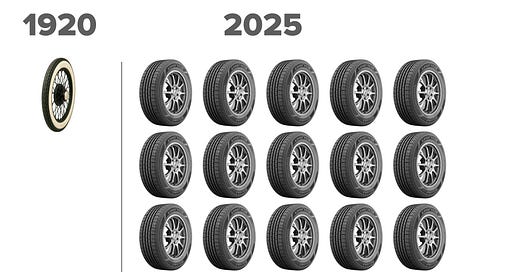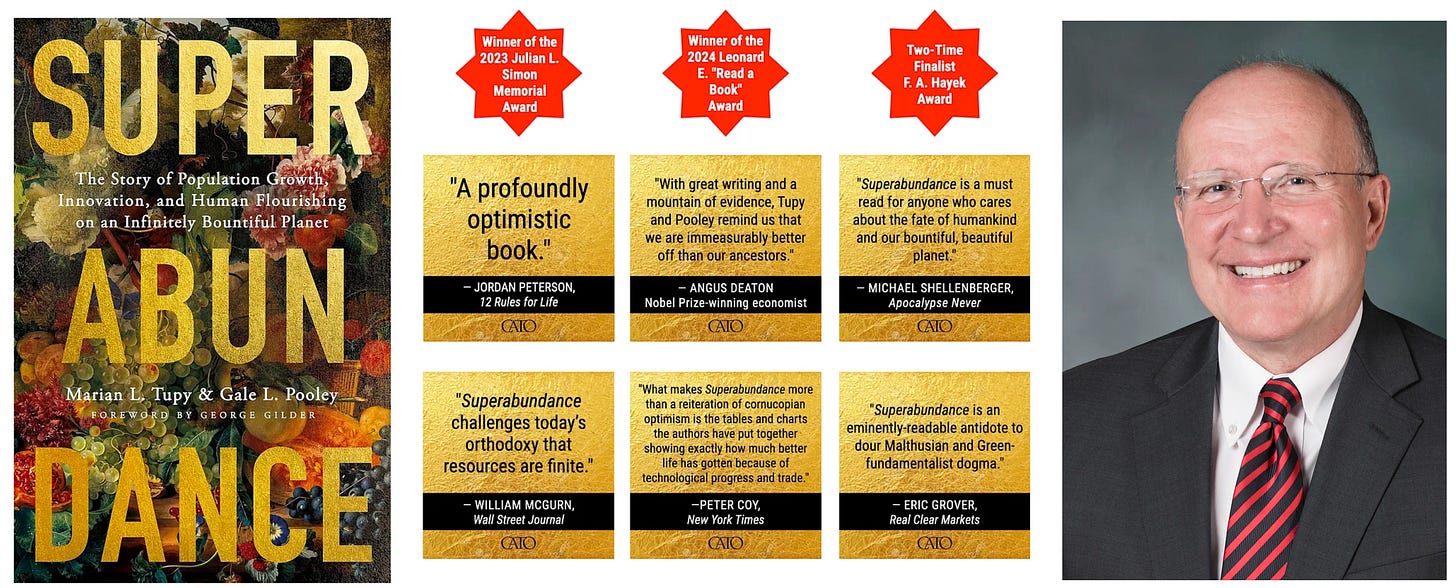In 1920 you could by a new Goodyear tire for your Ford, Chevrolet, Dort, or Maxwell for $21.50. A tube for the tire would add another $4.50. Unskilled workers at the time were earning around 29 cents an hour, putting the time price of the $26 combination at almost 90 hours.
Walmart sells the Goodyear Reliant 195/60R15 88V All-Season Tire for $77. Unskilled workers today are earning around $17.17 an hour, indicating a time price of 4.46 hours.
For the time it took to earn the money to buy a single tire in 1920, you get 20 of them today.
But car tires today are also vastly superior to those in 1920 due to advancements in materials, design, and manufacturing.
Materials: In 1920, tires were made from natural rubber with cotton or fabric cords, prone to punctures and rapid wear. Modern tires use synthetic rubber, steel belts, and advanced compounds (e.g., silica) for better durability, grip, and fuel efficiency. They last 50,000–80,000 miles versus 1,000–2,000 miles in 1920.
Construction: Early tires were bias-ply; their plies were arranged diagonally, with stiff sidewalls that limited handling and comfort. Radial tires, introduced in the 1940s and standard by the 1970s, offered better traction, stability, and ride quality due to their flexible sidewalls and steel-reinforced treads.
Performance: Modern tires are engineered for specific conditions (e.g., all-season, winter, high-performance) with optimized tread patterns for grip, water dispersion, and noise reduction. 1920s tires had basic treads, poor wet performance, and frequent blowouts at speeds above 30–40 mph. Today’s tires handle 100+ mph safely.
Safety: Tubeless tires, common since the 1950s, reduce blowout risks compared to 1920s tube-type tires. Modern tires also feature puncture-resistant layers and run-flat technology, absent in 1920.
Manufacturing: Precision engineering and computer-aided design ensure consistent quality in modern tires, unlike the handmade, inconsistent tires of 1920.
Quantitatively, modern tires are 40 to 60 times more durable, support 3 to 4 times higher speeds, and provide 5 to 10 times better grip, based on historical tire performance data and industry standards. These improvements stem from decades of innovation driven by safety, performance, and efficiency demands.
Applying a conservative 50x multiplier for all these qualitative improvements to the 20x reduction in time price suggests that today’s car tires are at least 1,000 times better than their 1920 counterparts.
The next time you’re cruising down the interstate at 75, say a little prayer of gratitude for the relentless pursuit of better tires—driven by ingenuity, competition, and the quest for progress.
Learn more about our infinitely bountiful planet at superabundance.com. We explain and give hundreds of examples why more people with freedom means much more resource abundances for everyone in our book, Superabundance, available at Amazon.
Gale Pooley is a Senior Fellow at the Discovery Institute, an Adjunct Scholar at the Cato Institute, and a board member at Human Progress.







Great article.
Many do not ask the question where does the tire material go as your tire wears on your passenger car or suv. Well it is burned off by friction as you drive. If it did not burn off, there would be piles of material on the sides of highways that came off the tires.
If you go to a racetrack and have the ability to access the track, you will see material from the race tires at the bottom of the track. The drivers call this stuff “marbles” because it’s round and will cause you to lose control if you get into it.
Lots of technology in tires.